Thirty years later the first glass-maker appears on the roll of the city’s freemen. But seven years previously we read that a certain townsman was admitted a freeman of the city upon his undertaking to train a city schoolboy, as his apprentice, in the difficult art of glass “grinding” without the usual premium of £7. But as early as 1666 an order was made by the City Council to the effect that “no stranger or foreigner should presume to open a shop, either with or without glass windows, under a penalty of £5”—a fact which seems to indicate that, although{116} glass windows may still have been a novelty, there existed facilities for their supply if required.
Apart from casual references like these, the history of Bristol glass is entirely obscure. But as the trade returns for the year 1695 show that the duty on glass for that year amounted to £17,642, and that a “drawback” allowed on exported glass amounted in the case of Bristol to no less a sum than £2976, it is pretty clear that by that time the industry in Bristol had assumed very considerable dimensions.
Bristol glass is certainly the most beautiful of all Old English glass, and there is no doubt that many of the fine specimens one sees, both coloured and plain, were actually produced in the factories of that city. The colouring of Bristol glass is exceptionally brilliant, especially its deep blues. The opaque milky-white ware, which is most common, is often “ribbed” with white streaks or ornamented with flowers in colours and gold, or daubed with red, blue, and yellow, or with one of these colours only. Fig. 29 shows specimens of both kinds.
It is a matter for great regret that the factories renowned in early times for the beauty and{117} finish of their output did not maintain their existence for a longer period. The exact date at which the famous opaque ware was made is open to considerable doubt, but the year 1760 cannot be very wide of the mark, for reasons to which I have already referred.
In any case, the records of the city show that in that year its glass furnaces were in full blast. We find recorded in 1715 a bequest of china and glass, and in a long account of a feast given to commemorate the accession of Queen Anne there is included among the expenditure of the corporation an item of £6, 14s. for glasses.
At first glass was extremely costly: the corporation was called upon to pay no less than £4, 16s. for “a glass to be placed in Mr Alderman Laroche’s coach, which was broken at the gaol delivery.” Fine specimens of the glass-worker’s art fetched extremely high prices.
The glass itself was exceedingly brittle and easily broken as compared with other English and Irish glass. It was frequently decorated with enamelled colouring, and many specimens are found with finely curved and twisted handles. It was, in my opinion, the object of the Bristol glass-houses to imitate white porcelain, and,{118} in support of this idea, we find manufactured in Bristol glass such articles as vases, cups and saucers, plates, mugs, and other utensils usually made from porcelain and earthenware.
Of course, the art of manufacturing this opaque white or milky glass was well known abroad. The white glass of Venice, of Orleans, and of Barcelona was already famous. The characteristic feature of its manufacture was the large amount of lead and the small quantity of tin employed as ingredients—quantities altogether out of proportion to those used in the manufacture of ordinary transparent glass.
It is no very difficult task for an enthusiast to find to-day excellent specimens of Bristol ware. Its characteristic features are an extraordinary fineness in colour and texture, coupled with a delicate taste both in hue and form. The ware, too, has a peculiar softness to the touch which is quite characteristic, and provides the amateur collector, once he has recognised it, with an excellent test as to the genuineness of the specimen under consideration. The smaller pieces are often beautifully decorated with painted or enamelled flowers, maidenhair fern, and the like.{119}
The illustrations (Figs. 25-26) give an excellent idea of the kind of decoration adopted by the master craftsmen of Bristol. The designs found upon Bristol glass were also, now and again, copies of those found on Venetian and French pieces. But, generally speaking, the decoration of Bristol glass was entirely English in conception and execution. This is particularly the case where the pieces were made for some special occasion or purpose, as, for example, the commemoration of some event of national importance.
Many examples from the Bristol factories are to be found in the various museums, especially at South Kensington, where in the famous Schrieber Collection are some of the finest examples extant. There is, for example, a “Venetian glass”—purely Bristol, of course, but on a Venetian model, which is reproduced as a frontispiece to this volume—and also a pair of candlesticks beautifully ornamented with butterflies, wild flowers, and leaves. They stand out as most admirable specimens from the Bristol factories.
It is a well-known fact that the Bristol product, so admirable was it in quality and appearance{120} and so closely did it resemble the real Venetian glass, was often passed off as the product of the Venice glass-makers—the pastmasters of the art. Many a collection, ostensibly hailing from Venice, must, on a closer scrutiny, be attributed to a place of origin much nearer home. This form of substitution was particularly prevalent in the case of glass ornamented with white twisted threads and in the case of ruby-coloured glasses and mugs.
Many of the earliest specimens were left “raw” at the base, and if the finger be drawn across the ends the existence of sharp edges will become apparent. This is a test of reasonably good value, as I have found on more than one occasion when I have been in doubt. Also, and with the smaller pieces in particular, it was almost universal with the Bristol manufacturer to leave untouched the “mark” or place where the piece was nipped from the blower’s tube. Modern reproductions, whilst faithfully observing and imitating all the beauties of the model, have generally their bases perfectly smooth. Even where the “mark” has been imitated to give an added air of verisimilitude to the specimen, the thing has been overdone, and that so
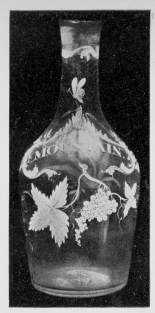
A BRISTOL GLASS DECANTER DECORATED WITH OPAQUE WHITE ENAMEL. THE WORD “MOUNTAIN” BEING THE NAME OF A KIND OF SPANISH WINE USED IN THIS COUNTRY, CIRC. 1760.
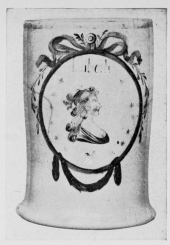
EARLY SPECIMEN OF BRISTOL GLASS MUG, WITH THE WORD “LIBERTY.”
FIG. 25.
awkwardly as inevitably to lead to detection. Sometimes, too, in the imitation, the colours used to produce the milky-white tone cease abruptly, leaving the “mark” perfectly transparent. In genuine old Bristol the colour fades gradually, leaving only the very tip of the “mark” clear.
Another good test is to place the specimen in a strong light, preferably sunlight. If, when examined, the colour is mixed, the piece is of doubtful authenticity. Spurious specimens often run “cloudy” or patchy, possibly because of bad mixing. This is, of course, a useful test, provided one does not rely upon it entirely, for certain specimens of undoubted authenticity display somewhat similar features. In particular, I remember an old drinking flask marked with irregular streaks of white, where this test would have proved absolutely misleading. Possibly the “feel” of the glass is the best criterion, genuine old Bristol being much softer to the touch than any modern imitation.
So many pitfalls await the average collector of Bristol glass that I should hardly advise anyone to make this his sole hobby, for although it is still possible to find small pieces—cups,{122} salt-cellars, small bowls, finger basins, mugs, and the like—the really important pieces of Bristol glass are few, and they and their owners are pretty well known to the cognoscenti. At any rate I have not met anyone, in recent years, who could boast of a considerable find in this direction.
A very fine specimen, described as “Old Bristol, 1760,” was put up for sale some eighteen months ago, near London. Its genuineness was further guaranteed by a label pasted on the base, showing that it had passed through a well-known London auction-room. The owner, a dealer in a small way, failing to find a customer in London, had put it into the sale of the effects of a cottage. It was bought in by its owner for £3, 3s., and eventually at the end of the day realised only 36s. I saw the piece subsequently. It was obviously a reproduction, though a very good one, and certainly worth what was given for it; but as he had purchased it as real old glass, and at a proportionate figure, it will, I fancy, be a long time before he again endeavours to secure a bargain in Old Bristol. I have known many such instances, and as a result of my experience I have come{123}
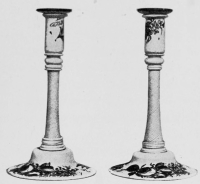
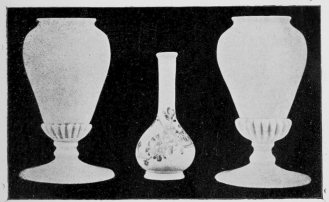
FIG. 26.—SPECIMENS OF BRISTOL GLASS.
(Enamel Colouring by Michael Edkin.)
to the conclusion that, while pieces of Bristol can be picked up now and again, particularly in the west of England, it will not pay the amateur collector to confine himself to this particular variety.
I am indebted to Mr Cole of South Molton Street, London, for the illustration (Fig. 26) of a pair of very fine early Bristol vases which, although undecorated, are exquisite in colour and form, and a beautiful example of the maker’s art. The frilling round the base deserves special notice.
The central piece in the photograph is a long-necked vase decorated with coloured enamels, and known to be the work of Michael Edkin, a Bristol enameller of distinction. If carefully examined, it affords ample evidence of the skill and painstaking care to which the best specimens of this ware owe their artistic merit.
Spiral wine glasses are still often to be found in or near Bristol, and the fact that these are rarely found in other parts of the country seems to indicate that they were a favourite form with the Bristol glass-makers. Among the examples of Bristol ware here reproduced (Fig. 27) is included a pair of vases. These{124} rank among the finest specimens still extant of Michael Edkin’s work. This talented artist was a painter of some merit, who gradually drifted into glass painting, and for some twenty-six years, from 1762 to 1788, was engaged by various firms to decorate their ware with birds, flowers, etc. He was also, it may be added, a singer and an actor of no little distinction.
Fig. 26 shows a pair of candlesticks, 6? inches in height, from the British Museum Collection. They are excellent examples of Edkin’s taste and delicacy of execution. Great quantities of glass decorated by him must have been exported, and I have found undoubted specimens of his work in Rome and the museums of other Continental cities I have visited. One of the very finest specimens of his art is a richly gilt and decorated tea-tray, now in the Museum of Practical Geology. Another example from the British Museum Collection is the fine mug, ornamented with a portrait and the word “Liberty” in gold, possibly made by some sympathiser with the revolutionary spirit which strongly affected Britain as well as France towards the close of the eighteenth century.

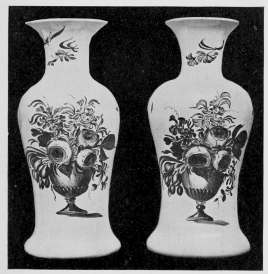
FIG. 27.—SPECIMENS OF OPAQUE WHITE BRISTOL GLASS. 18th CENTURY.
(Decorated by M. Edkin.)
Edkin also decorated many blue ground pieces, and it is interesting to learn that his remuneration for the ornamentation of a jug in colour and gilt, which must have taken a considerable time, was the lordly sum of 8d., a striking commentary upon the value placed upon skilled craftsmanship in the eighteenth century. Like many other artists he had to be content with the posthumous reward which fame bestows.
The Bristol factories are said to have made all sorts of articles, flasks, bells, walking-sticks, bellows, etc., in glass, but there is much uncertainty on this head, and I doubt if the greater part of such articles classified as coming from Bristol should not, as a matter of fact, claim Nailsea as their place of origin. We can certainly ascribe oil, vinegar, and pepper pots, candlesticks, salt-cellars, and vases to Bristol, as the daintily decorated pepper and sugar castors, shown in Fig. 27, prove, so that it is at least possible for the other articles enumerated also to have been made there, but where there is so much uncertainty, the collector who desires to be on the safe side had better refrain from giving Bristol the benefit of the doubt.
It must not be inferred, however, that all{126} Bristol glass is of the opaque kind. The magnificent piece shown in the frontispiece is quite transparent, the apparent opacity of the background of the landscape being due to enamel laid on the glass. The fine decanter reproduced in Fig. 25 is also an example of what Bristol could do in transparent glass, the decoration, here again, being in enamel.
Nailsea Glass.—The glass-works of Nailsea were established in 1788, a few miles to the south-west of Bristol, and were, for some time, carried on with success; but the ware was crude and lacking in the finish characteristic of the best Bristol specimens. The earliest pieces were made of yellowish or dark green glass, with blotches of white, as in the jug shown in Fig. 28. They were usually very inferior in style, colour, texture, and workmanship, and were consequently not greatly sought after by purchasers; hence the output was restricted, and the factory after a while seems to have confined its efforts to producing plain white glass with quaint and curious forms of decoration. A pair of bellows, for example, was decorated like the fins of a fish, with tiny projections and spines all over it. Towards the
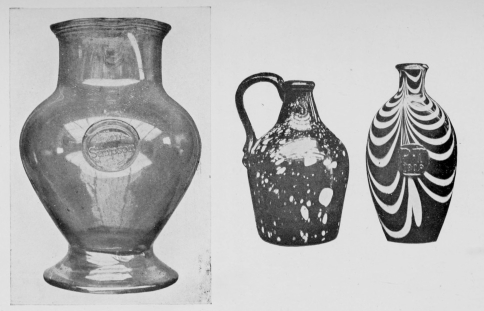
FIG. 28.—EARLY NAILSEA GLASS JUGS. EARLY 19th CENTURY.
end of its career, which closed in 1763, the output was a clear glass of greenish tint, with faintly coloured streaks. Fig. 29 is a characteristic example. I have also seen a few pieces gilt. The glass is now exceedingly scarce, and good specimens command a very high price. There is a curious charm about Nailsea glass. In appearance, the best specimens are of a dark toffee-like colour, and when held up to a strong light exhibit a greenish tinge. The lighter and finer kinds display a characteristic ground which, if not beautiful, is certainly quaint. Collectors who are fortunate enough to come across a specimen of Nailsea at a reasonable figure should undoubtedly seize the opportunity of acquiring it, but such opportunities are few and, were they more numerous, it is hardly likely that anyone would wish to form a large collection of it. The “Simpson” Jug, illustrated in Fig. 28, is transparent, but of a curious yellowish-green tinge, and is probably one of the last pieces produced at the old factory.

